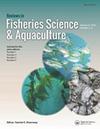Overlap of Home Ranges of Resident and Introduced Southern Rock Lobster after Translocation
引用次数: 8
Abstract
Translocation, sea ranching, and assisted migration are under scrutiny as methods to augment populations so that harvests can be increased or populations can better adapt to changing environmental conditions. Understanding the ecological effects of any such environmental manipulation is critical to its successful application. One potential ecological effect of any type of stock enhancement is the displacement of either resident or released groups such that finding shelter or foraging habitat is adversely affected. This study examined behavioral interactions of resident and translocated Jasus edwardsii rock lobster after an introduction of 1,961 “small pale” phenotypic morphs to an area populated by the resident “large red” phenotypic morph. This translocation was an experimental stock enhancement conducted as part of a larger study to increase the yield and value of the fishery. Most translocated individuals established a home range within a couple of days of release (generally <2), and these ranges were generally less than 1.0 ha in size. Home-range kernels and foraging ranges overlapped between the two morphs, and there was no evidence of avoidance (Jacob's cohesion index 0.01, Z = 1.06, p = 0.28). This case of translocation for stock enhancement between ecotypes had no detectable adverse effect on either the resident or the translocated population, and in this species, stock enhancement could become part of an integrated conservation and harvest optimization strategy.迁移后留种和引进的南方岩龙虾的活动范围重叠
作为增加种群数量的方法,迁移、海上牧场和辅助迁移正在接受审查,以便增加收成或使种群更好地适应不断变化的环境条件。了解任何此类环境操纵的生态影响对其成功应用至关重要。任何种类的种群增加的一个潜在的生态影响是迁离居住或放归的种群,从而对寻找庇护所或觅食生境产生不利影响。本研究在将1961种“小苍白”表型型的爱德华螯虾引入到“大红色”表型型的居住区域后,研究了居住和易位的爱德华螯虾的行为相互作用。这种易位是一项实验性的种群增加,是增加渔业产量和价值的更大研究的一部分。大多数迁移个体在释放后的几天内(一般小于2天)建立了一个家园范围,这些范围的大小通常小于1.0公顷。两个变种的家核区和觅食区存在重叠,不存在回避现象(Jacob’s cohesion index 0.01, Z = 1.06, p = 0.28)。在这种情况下,种群数量增加在生态型之间的易位对居住种群和易位种群都没有明显的不利影响,在该物种中,种群数量增加可以成为综合保护和收获优化策略的一部分。
本文章由计算机程序翻译,如有差异,请以英文原文为准。
求助全文
约1分钟内获得全文
求助全文

 求助内容:
求助内容: 应助结果提醒方式:
应助结果提醒方式:


